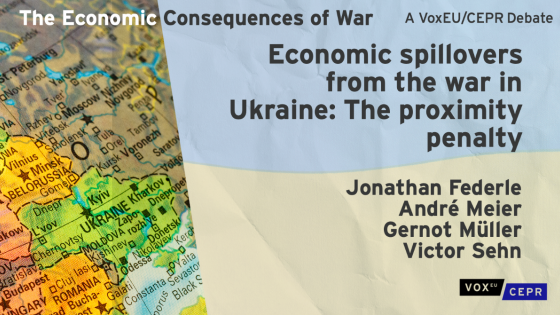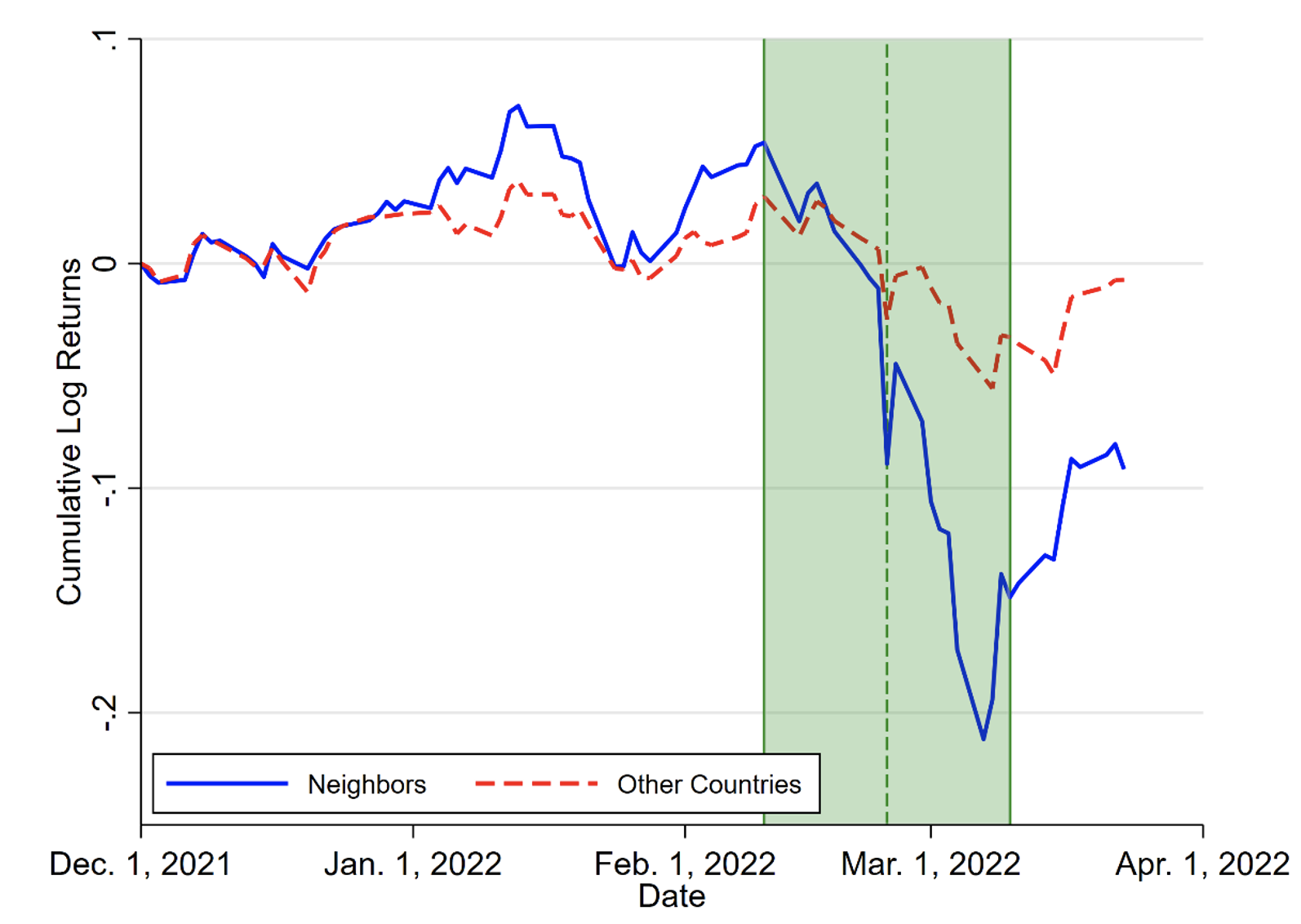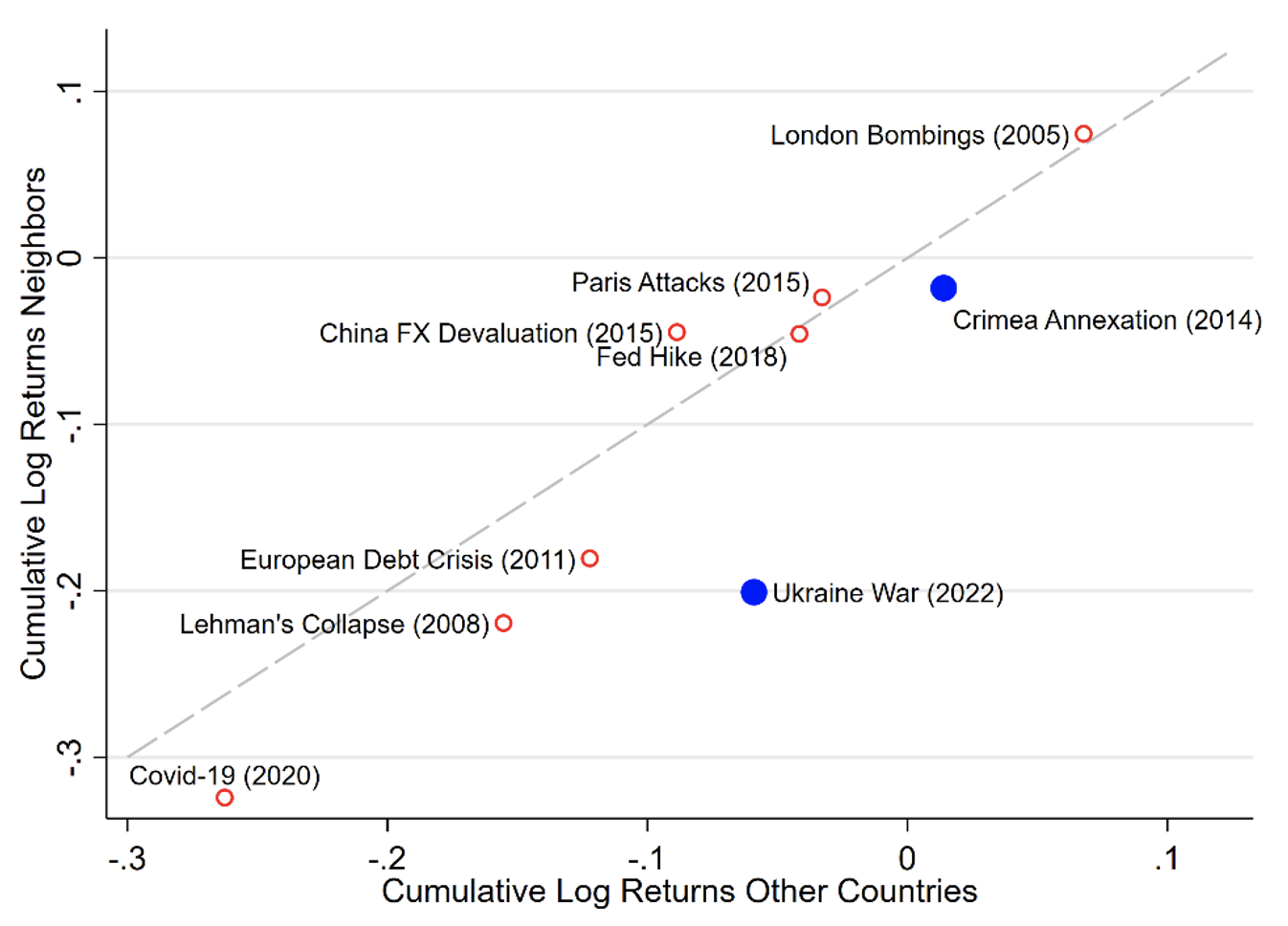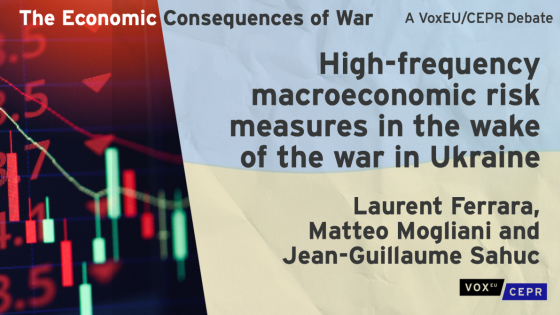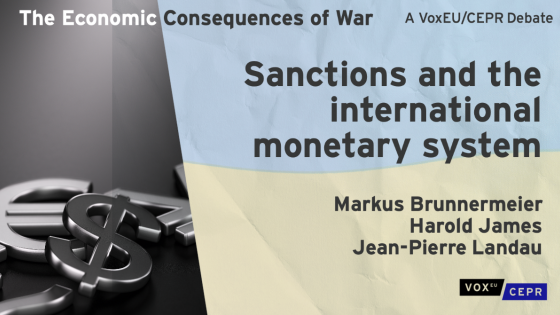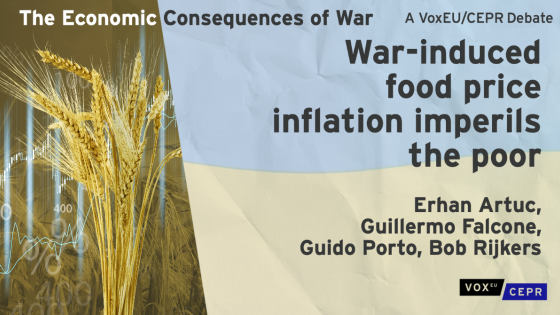Editors' note: This column is part of the Vox debate on the economic consequences of war.
The war in Ukraine is an event with far-reaching repercussions both in terms of geopolitics and the international financial system (Brunnermeier et al. 2022). It is natural to discuss it in the context of other major events, such as the global financial crisis or the global climate crisis (Muellbauer and Aaron 2022). As with these other events, the economic repercussions are not distributed evenly around the globe (Ferrara et al. 2022). Rather, they differ substantially across countries – and, in the case of the war in Ukraine, geographic distance to the theatre of the war appears to be a key differentiator.
Geographic proximity to the war is key for economic spillovers
In a new paper (Federle et al. 2022), we highlight this dimension of the economic spillovers from the war by identifying a ‘proximity penalty’ in equity returns: the closer geographically a country is to Ukraine, the more pronounced the decline in its equity market around the time the war started. Specifically, we focus on the stock market response to the Russian invasion of Ukraine on 24 February 2022. We study returns in a four-week window centred around this date to capture the market impact of the invasion as well as possible anticipation effects.
Our sample consists of 66 economies for which we measure the cumulative stock market return based on MSCI indices during the event window. To illustrate our main point, we distinguish 15 first- and second-degree neighbours of Ukraine (“Neighbours”) from the remaining “Other countries” in our sample. Figure 1 shows the average cumulative log return for both groups of countries. The green dashed line marks the onset of the war on 24 February, while the green area indicates the event window. The difference across groups is stark: within the four weeks around the onset of the war, the neighbours experienced an average stock market decline of over 20% (solid blue line), whereas the more distant countries (red dashed line) saw their markets decline by less than 6% on average.
Figure 1
Notes: “Neighbours” is an unweighted average of 15 European first- and second-degree neighbours of Ukraine; ”Other Countries” is the average of the remaining 51 countries in our sample. Russia and Ukraine are excluded from both groups. Returns are computed based on Morgan Stanley Capital International (MSCI) country index. The green area (“event window”) demarcates the period from two weeks prior to the onset of the war until two weeks after, that is, from 10 February to 10 March 2022.
Figure 2 further illustrates the exceptional nature of the stock market response along the dimension of neighbours versus other countries. It shows the cumulative stock market returns over a four-week window around eight other significant financial or geopolitical events, alongside the Ukraine war episode. We measure the average performance of Ukraine's “neighbours” along the vertical axis and that of the “other countries” along the horizontal axis. The war in Ukraine stands out, especially in the relative size of stock market losses for the neighbours – a clear indication of how asymmetrically different economies are being affected by the war.
Figure 2
Notes: “Neighbours” is an unweighted average of 15 European first- and second-degree neighbours of Ukraine; ``Other Countries'' is the average of the remaining 51 countries in our sample. Russia and Ukraine are excluded from both groups. Returns are computed based on Morgan Stanley Capital International (MSCI) country index. The vertical axis measures cumulative log returns over four weeks around major geopolitical or financial events for Neighbours, horizontal axis for Other Countries.
Trade or military spillover risk?
What determines the apparent proximity penalty? To guide our analysis, we distinguish two leading hypotheses. First, neighbours are more exposed to the war via trade linkages – broadly understood – because, all else equal, distance is a key barrier to trade (e.g. Head and Mayer 2014). Second, neighbours also face a larger risk of becoming involved in the war, as they may suffer military spillovers in the form of direct attacks on their territory or collateral damage from the use of weapons of mass destruction in the neighbouring country, to name but two examples. Via such trade and military spillovers, wars weigh on economic activity and make large economic disasters more likely. This, in turn, will manifest itself in equity prices (Barro 2006, Caldara and Iacoviello 2022).
To explore the issue formally, we estimate a set of simple regression models which relate the cumulative stock market return during the event window to a country’s distance from Ukraine (measured in 1,000 kilometres), a country’s typical sensitivity to world equity markets (beta) and a series of trade and EU membership variables. For the simplest specification we find that a direct neighbour to the conflict (at a distance of zero) suffers a stock market decline of 23.1% by the end of the second week of the war; this effect empirically diminishes by about 2.6 percentage points for every 1,000 kilometres of distance from Ukraine. Also accounting for spillovers via the trade channel – we control not only for direct trade relations between a country and the countries at war but also for indirect effects related to the importance of Russia and Ukraine as global commodity exporters – reduces the proximity penalty to 1.0 percentage points per 1,000 kilometres.
Thus, trade spillovers are quantitatively important but still leave a meaningful role for other factors in driving stock returns around the onset of the war. Military spillovers are likely to be another critical factor. Indeed, we find a clear empirical relationship between excess returns during our event window and an independent ‘geopolitical risk’ variable proposed by Caldara and Iacoviello (2022). The riskiness of individual countries captured by this variable correlates positively with geographic proximity to Ukraine, and negatively with stock market returns around the onset of the war.
A sectoral perspective provides further evidence for the importance of military spillover channels. Specifically, we document that companies operating in the aerospace and defence sector and listed in one of the neighbouring countries saw their equity prices rise markedly on average during the event window, even as the general stock market in these countries sold off sharply. We find no such marked outperformance for defence companies in other countries. Thus, defence companies – almost certainly in anticipation of future business orders in the wake of the war in Ukraine – are a notable exception that proves the general rule of the proximity penalty.
Summary
Financial markets responded quickly to the Russian invasion of Ukraine by pricing in a proximity penalty. This penalty likely reflects countries’ specific economic exposure to the war, both because of trade linkages – typically closer among neighbours – and due to greater risk of direct military spillovers. Actual economic developments in coming months will clarify how important either of these effects really are, and what they imply for the wider economic outlook for Europe.
References
Barro, R J (2006), “Rare Disasters and Asset Markets in the Twentieth Century”, The Quarterly Journal of Economics 121(3): 823–866.
Brunnermeier, M K, H James and J-P Landau (2022), “Sanctions and the international monetary system”, VoxEU.org, 5 April.
Dario, C and M Iacoviello (2022), “Measuring Geopolitical Risk”, American Economic Review 112(4): 1194-1225.
Federle, J, A Meier, G Müller and V Sehn (2022), “Proximity to War: The stock market response to the Russian invasion of Ukraine”, CEPR Discussion Paper 17185.
Ferrara, L, M Mogliani and J-G Sahuc (2022), “High-frequency macroeconomic risk measures in the wake of the war in Ukraine”, VoxEU.org, 7 April.
Head, K and T Mayer (2014), “Gravity Equations: Workhorse, Toolkit, and Cookbook”, in G Gopinath, E Helpman and K Rogoff (eds), Handbook of International Economics, Volume 4, Elsevier.
Muellbauer, J and J Aron (2022), “The global climate accelerator and the financial accelerator: Commonalities and implications from Putin’s war”, VoxEU.org, 24 March.
